
The Beaver
in the Ostfalen Technology Park
The beaver in the Kleine Sülze creek near Barleben -
a landscape designer for biodiversity
Physique and lifestyle
The European beaver (Castor fiber) is our largest indigenous rodent with a total length of up to 135 cm. With a body weight of 20 to 30 kg, he weighs almost as much as a fully grown deer. While he appears rather slow and awkward with his short legs on land, the beaver is excellently adapted to life in the water thanks to his flattened tail ("trowel") and his pronounced webbed skin. Here he is superior to many other species in terms of speed, dexterity and endurance. In the event of imminent danger, he dives below the surface of the water and then reappears a little later in a completely different place.
In summer, the beaver's food consists of various herbs, reeds or cattails. In winter he prefers to eat twigs and bark from willows and poplars, but also from many other trees. Its strong orange-red incisors grow, as with all rodents, the whole life.
The life expectancy of a beaver is 10-15 years. A family network consists of the monogamous parents and the offspring from two successive years. The beaver digs his dry living tubes into the embankment. The entrance is basically below the water surface, making it inaccessible to predators. As soon as the ceiling over the building becomes too thin and threatens to collapse, the soil and branches are piled up, which leads to the emergence of the typical beaver castles.
Occurrence
Beavers once populated almost all waters of the lowlands and hills in Europe. Through intensive hunting, however, he was almost exterminated by the end of the 19th century. Thanks to the efforts of a few people in the region around Dessau, a remnant of the Elbe beaver subspecies could survive and thus be saved from extinction. The stocks on the middle Elbe and its tributaries have been recovering for about 50 years. Little by little beavers are returning to the river basin of the Weser and other rivers. Certain sections of the Telzgraben creek and the Kleine Sülze creek in the technology park have also been successfully repopulated in recent years.
Landscapers
If the water is too shallow for the beaver, he builds a stable dam from branches and twigs of trees in a suitable place, which he previously felled with his strong nibbles. This dam is then regularly sealed and repaired with mud and stones from the bottom of the water, so that almost no water can run through it. This creates so-called "beaver ponds" from a few square meters to several hectares in size, in which the beaver can swim and dive freely. Adjacent areas are (again) wetted. The increased groundwater level means that trees and shrubs that are not adapted to the location die, which creates valuable clearings. Structured aquatic landscapes develop from straightened and evenly flowing streams, in which many other species find a habitat. Like hardly any other animal, the beaver is able to change entire landscapes in favor of biodiversity.
Biodiversity in the beaver territory
The biodiversity in a beaver area is demonstrably particularly high. For example, at the beaver dam, animal and plant species of standing and fast-flowing waters live side by side. The formation of shallow and deep sections of water leads to an increase in insects and other invertebrates, which automatically improves the food availability for more developed animal species. Rotting deadwood and submerged branches of dead trees offer a variety of hiding places for young fish, tadpoles and insect larvae.
Both the dam and the beaver's living area offer small niches and hiding places with different temperature and humidity conditions. Due to the reduced flow speed, the water temperature rises above the Beaver Dam and sediments are deposited on the water bed. The associated nutrient enrichment allows plant species to thrive, which in turn ensure the beaver's diet throughout the year.
Conflicts and benefits
Due to the straightening of many rivers and the drainage of wetlands, the habitats of many native animal and plant species have been largely destroyed. In today's cultural landscape, the return of the beaver often leads to conflicts due to closely adjacent buildings and intensive land use.
Since 1992, beavers have been included in Appendix II of the Fauna-Flora-Habitats Directive (92/43 / EEC) as a strictly protected species of common interest, for the preservation of which protected areas have to be identified and suitable habitats have to be restored.
Where there is sufficient space for activities, beaver ponds have been shown to perform important functions in flood protection. In these natural water retention basins, excess water can evaporate over a large area and gradually seep into the groundwater. During long periods of drought, beaver ponds, on the other hand, ensure the survival of many aquatic species.
Activities in the technology park
Since 2011, NABU Barleben e.V., the technology park and the district of Börde have been working on the implementation of the joint project "Increasing biodiversity on the grassland areas of the technology park in Ostfalen". The construction activity of the beaver can be tolerated in parts of the park, as neither the commercial nor the agricultural use of adjacent areas is impaired. The project partners observe and document the landscape design by the beaver and its positive impact on biodiversity. The aim is to make this natural spectacle tangible for visitors to the TPO and to resolve emerging conflicts in a professional manner.
The reservoir of the Little Sülze creek occasionally leads to the flooding of adjacent cycle and footpaths, which is why sections of the path system had to be artificially increased in the past. Adapted land use for the temporarily flooded grasslands is intended to support the desired spread of typical plant species appropriate to the location.
In order to create sufficient food sources for the beaver in the long term, additional young willows have been planted on the banks of the Kleine Sülze creek in the past 15 years. As typical softwood species in the floodplain landscapes, they are adapted for use by beavers. They sprout quickly and store bitterns in the tissue in the first few years, protecting themselves from being bitten again early. This means that the beaver can only access these renewable raw material sources once sufficient plant material has been able to grow again. The bite thus also contributes to the natural rejuvenation of water-bearing trees and can make manual maintenance by humans unnecessary.
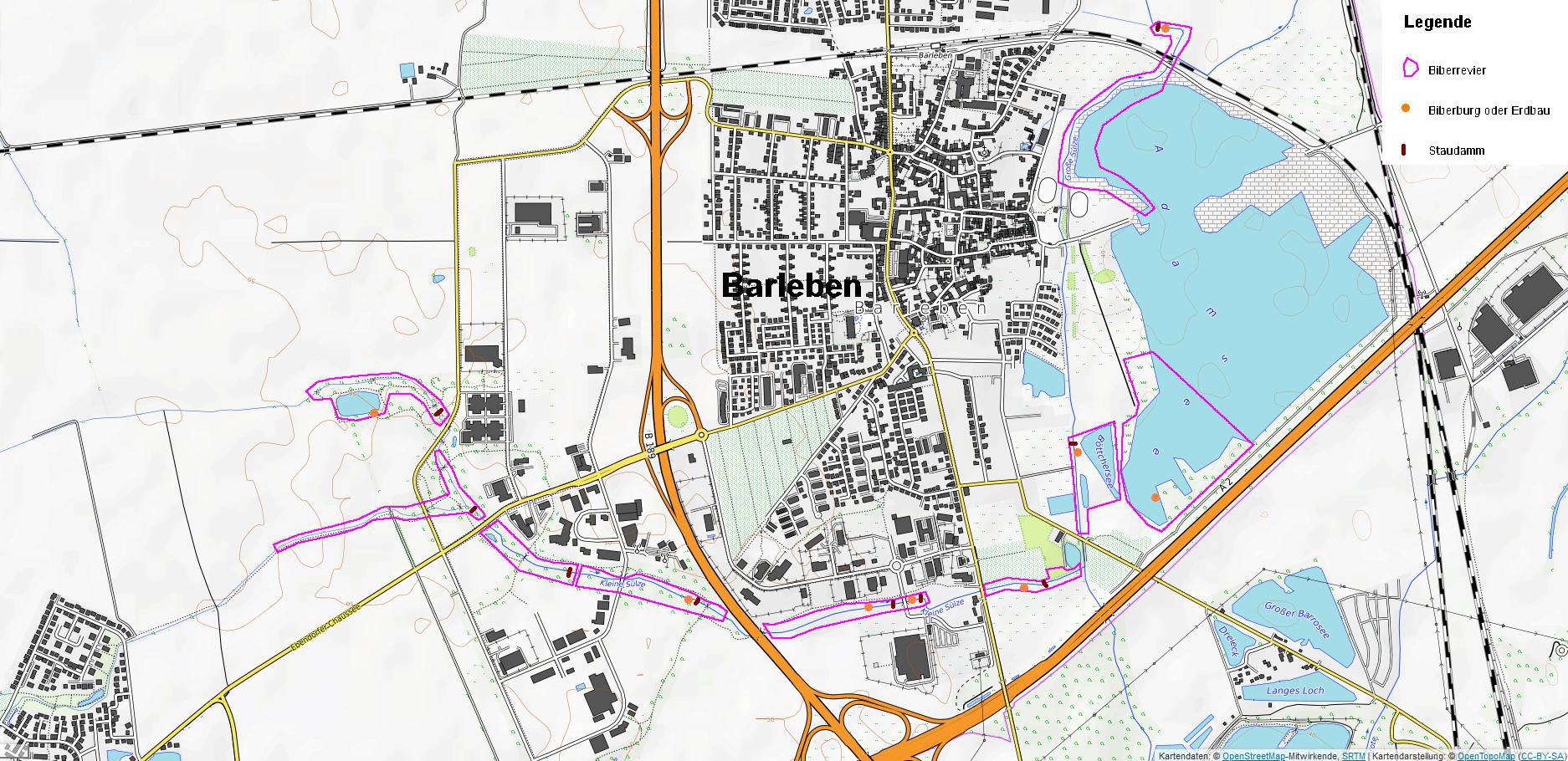 Beavers have built several dams in the waters around Barleben. Since the animals change between the territories depending on the prevailing conditions, they are not all occupied at the same time.
Beavers have built several dams in the waters around Barleben. Since the animals change between the territories depending on the prevailing conditions, they are not all occupied at the same time.
 The imposing Beaver Dam in the south-eastern part of the technology park has dammed up the Kleine Sülze, so that a sunny, open water surface has been created. Such open water areas make it easier for dragonflies and bats to hunt flying insects.
The imposing Beaver Dam in the south-eastern part of the technology park has dammed up the Kleine Sülze, so that a sunny, open water surface has been created. Such open water areas make it easier for dragonflies and bats to hunt flying insects.
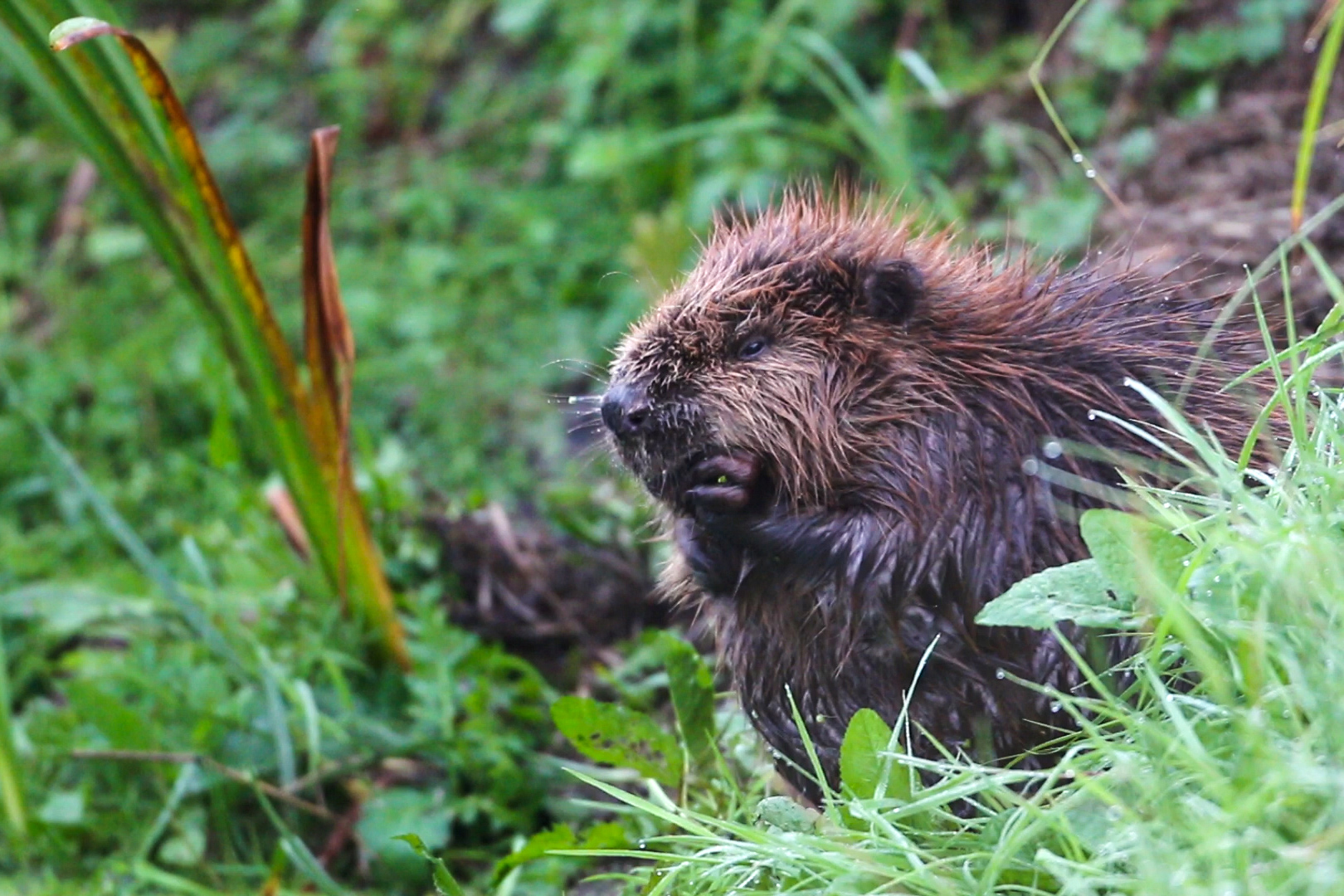 The beaver (Castor fiber) redesigns certain areas of the technology park according to its taste. In order to raise the water level, he created several barrages in the Kleine Sülze creek. As a result, neighboring grasslands become wet and cycle and hiking trails are flooded at times.
The beaver (Castor fiber) redesigns certain areas of the technology park according to its taste. In order to raise the water level, he created several barrages in the Kleine Sülze creek. As a result, neighboring grasslands become wet and cycle and hiking trails are flooded at times.
(Foto: NABU/ Klemens Karkow)
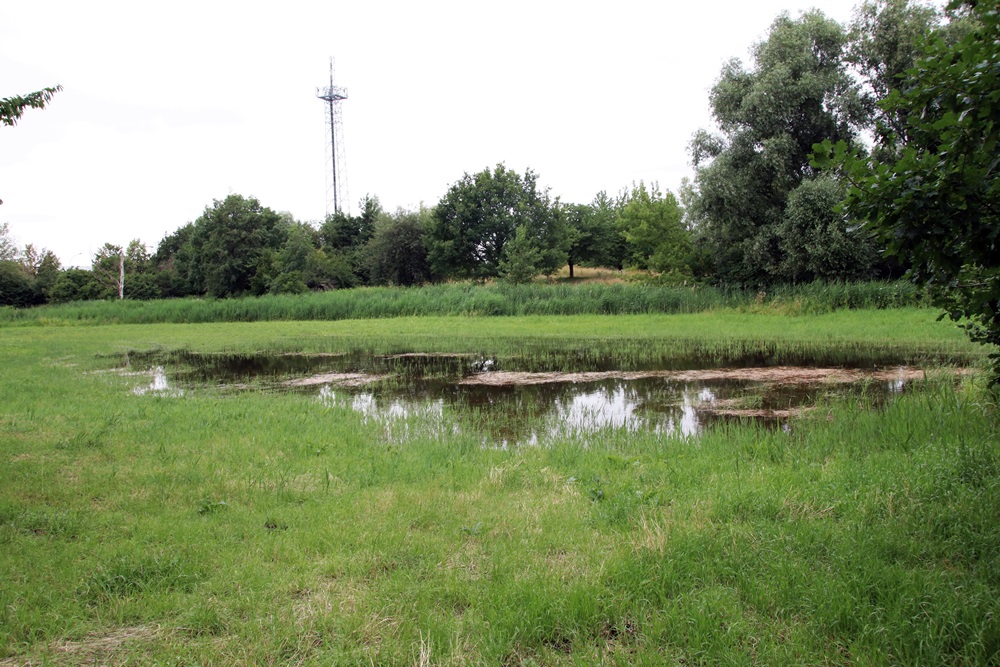 The adjacent wet meadows have been under water in places since the Kleine Sülze creek was dammed up. These newly created, sun-drenched shallow water pools represent valuable spawning habitats for amphibians and dragonflies.
The adjacent wet meadows have been under water in places since the Kleine Sülze creek was dammed up. These newly created, sun-drenched shallow water pools represent valuable spawning habitats for amphibians and dragonflies.
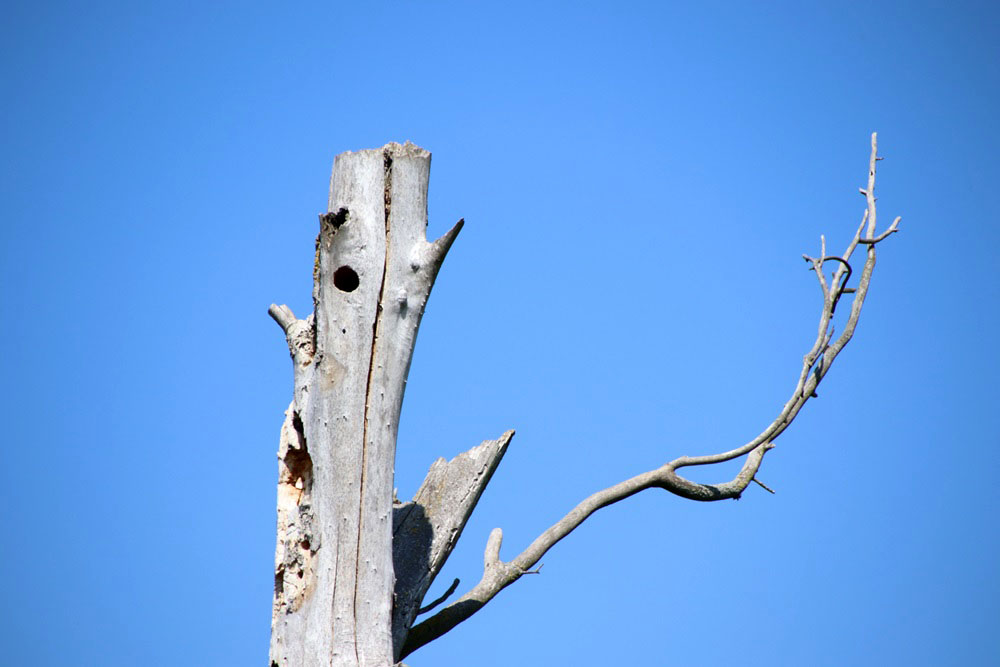 Dead trees are important for species that nest in deadwood or feed on the insect larvae that live in them. Hornets and wasps often nest in abandoned woodpecker caves and crevices. Bats use such structures as hiding places.
Dead trees are important for species that nest in deadwood or feed on the insect larvae that live in them. Hornets and wasps often nest in abandoned woodpecker caves and crevices. Bats use such structures as hiding places.
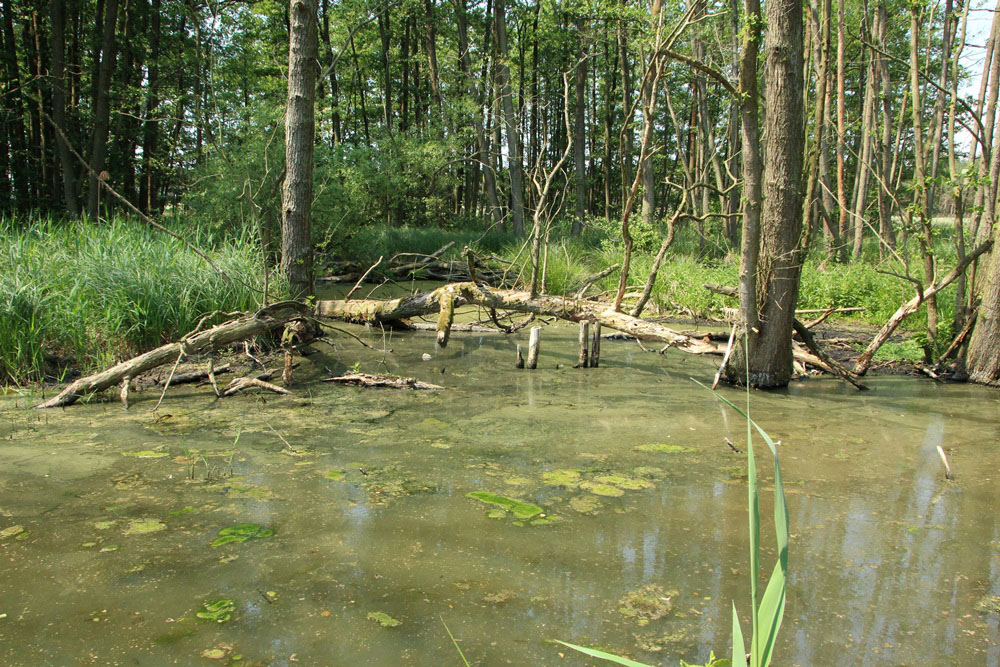 Where trees die due to the increased water level, there are sunny clearings and the structural diversity increases enormously. Dragonflies use the branches that protrude just above the water surface as a waiting area to defend their territories against rivals and to spot potential prey.
Where trees die due to the increased water level, there are sunny clearings and the structural diversity increases enormously. Dragonflies use the branches that protrude just above the water surface as a waiting area to defend their territories against rivals and to spot potential prey.
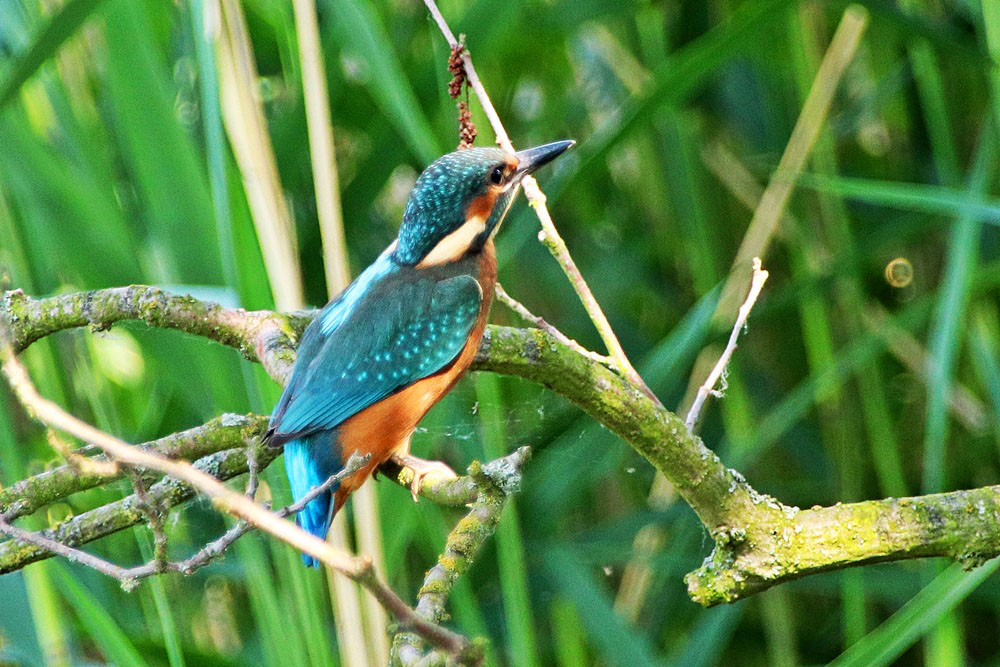 The kingfisher (Alcedo atthis) also uses dead branches as a place to find small fish in the water. He can put his brood tubes in the root plates of fallen trees.
The kingfisher (Alcedo atthis) also uses dead branches as a place to find small fish in the water. He can put his brood tubes in the root plates of fallen trees.
 Where many insects develop in the newly created shallow water zones and swarm around after hatching, new food sources for wagtails (Motacilla alba) and other types of water landscape open up.
Where many insects develop in the newly created shallow water zones and swarm around after hatching, new food sources for wagtails (Motacilla alba) and other types of water landscape open up.
(Foto: Gertraud Rehberg)
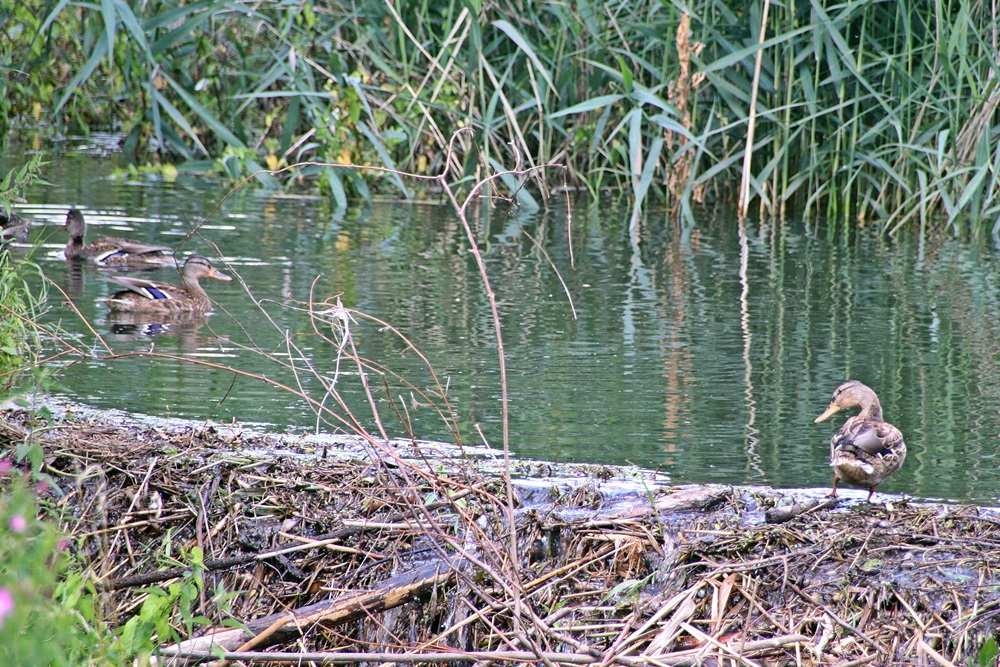 Mallards (Anas platyrhyncho) use the beaver dam as a resting place. From here they have a good overview of the surroundings and can slide into the protective water immediately if there is a potential danger.
Mallards (Anas platyrhyncho) use the beaver dam as a resting place. From here they have a good overview of the surroundings and can slide into the protective water immediately if there is a potential danger.
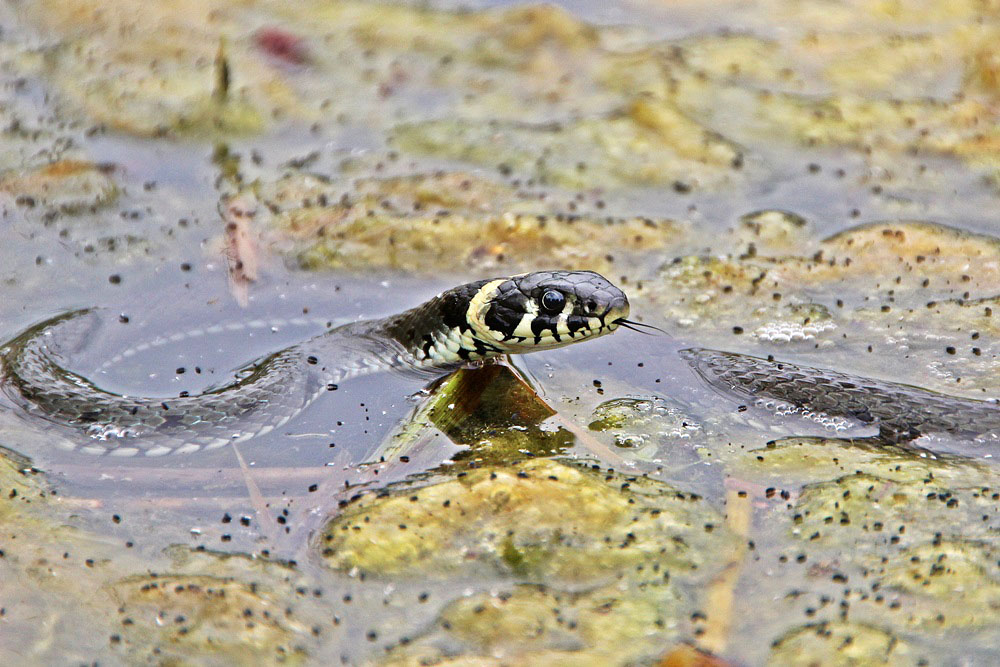 Grass snakes (natrix natrix) are frequent "subtenants" in the structurally rich beaver castles, as they find suitable places for sunbathing and eggs to lay down here. The numerous niches offer young snakes sufficient protection in the immediate vicinity of sunny shallow water areas, where they hunt for frogs and small fish.
Grass snakes (natrix natrix) are frequent "subtenants" in the structurally rich beaver castles, as they find suitable places for sunbathing and eggs to lay down here. The numerous niches offer young snakes sufficient protection in the immediate vicinity of sunny shallow water areas, where they hunt for frogs and small fish.
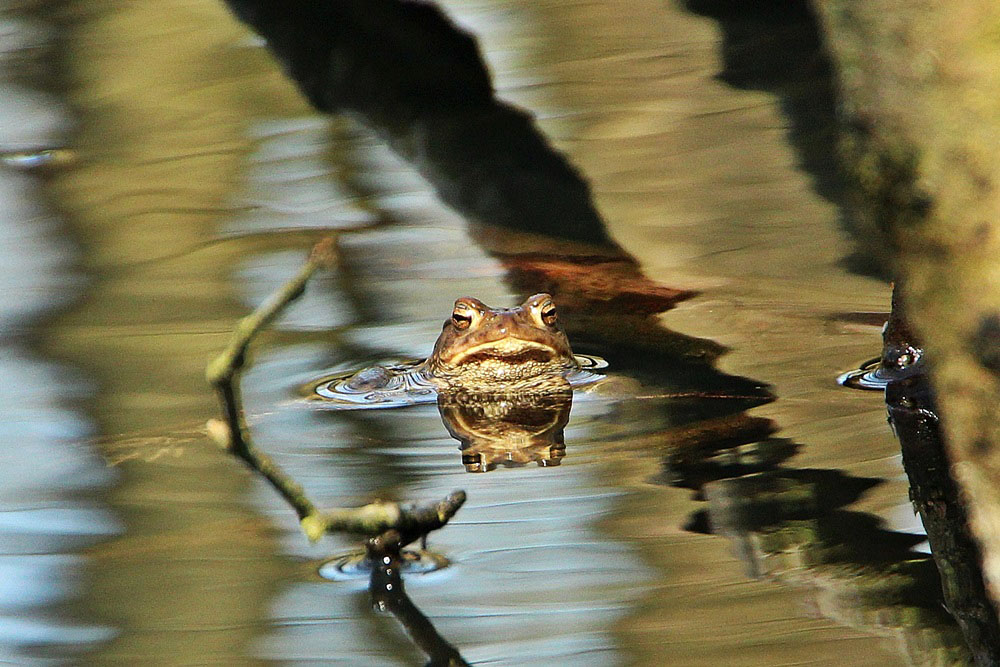 Beaver landscapes create valuable habitats for amphibians. Ideal spawning habitats for toads (Bufo bufo) and other species are created in the shallow water zones. Deadwood structures on land serve as hiding places and wintering quarters.
Beaver landscapes create valuable habitats for amphibians. Ideal spawning habitats for toads (Bufo bufo) and other species are created in the shallow water zones. Deadwood structures on land serve as hiding places and wintering quarters.
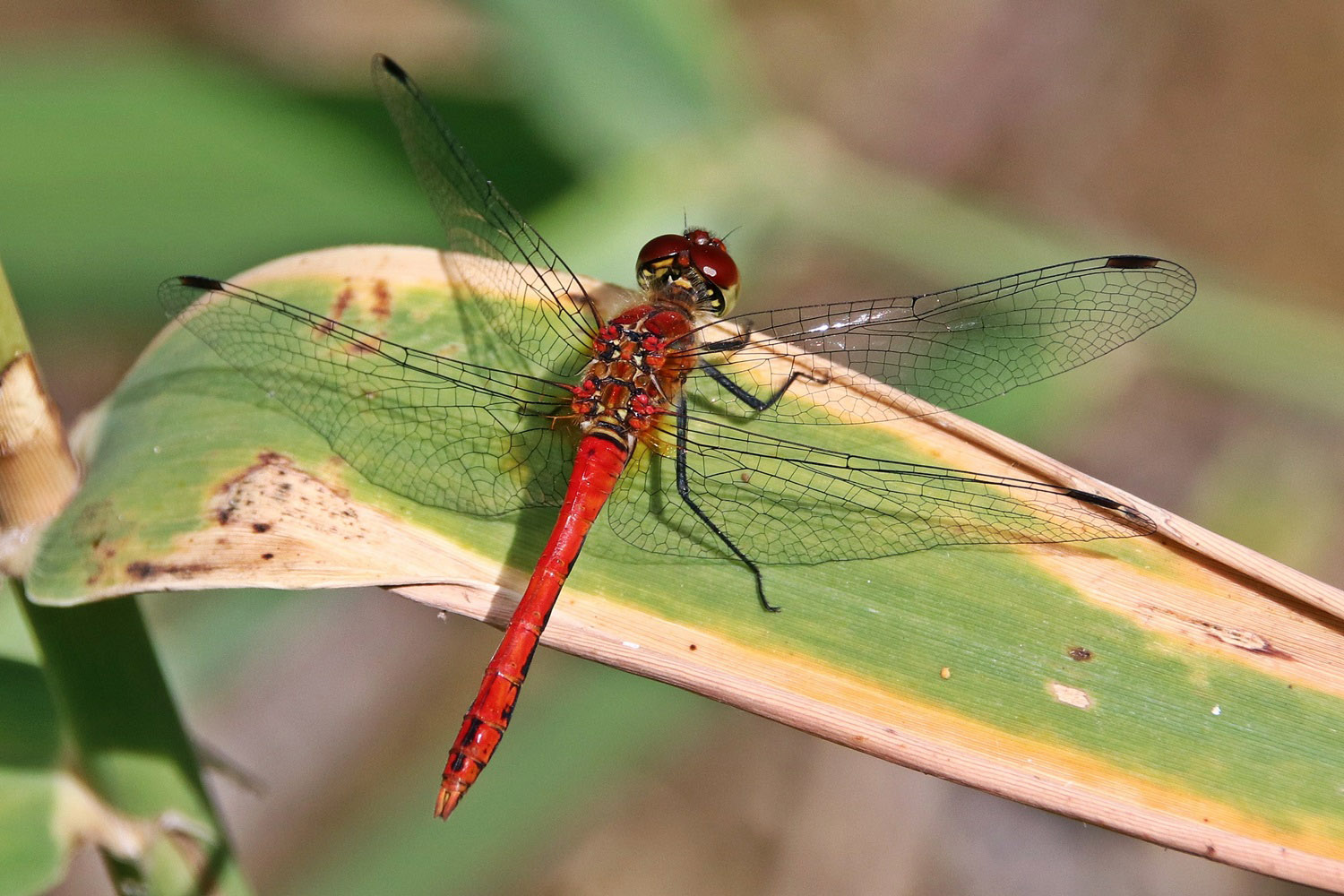 The ruddy darter (Sympetrum sanguineum) is one of the first dragonfly species to inhabit the newly created, calming beaver pond. The eggs are laid directly over the moist ground areas of the beaver dam, which is compacted with mud.
The ruddy darter (Sympetrum sanguineum) is one of the first dragonfly species to inhabit the newly created, calming beaver pond. The eggs are laid directly over the moist ground areas of the beaver dam, which is compacted with mud.
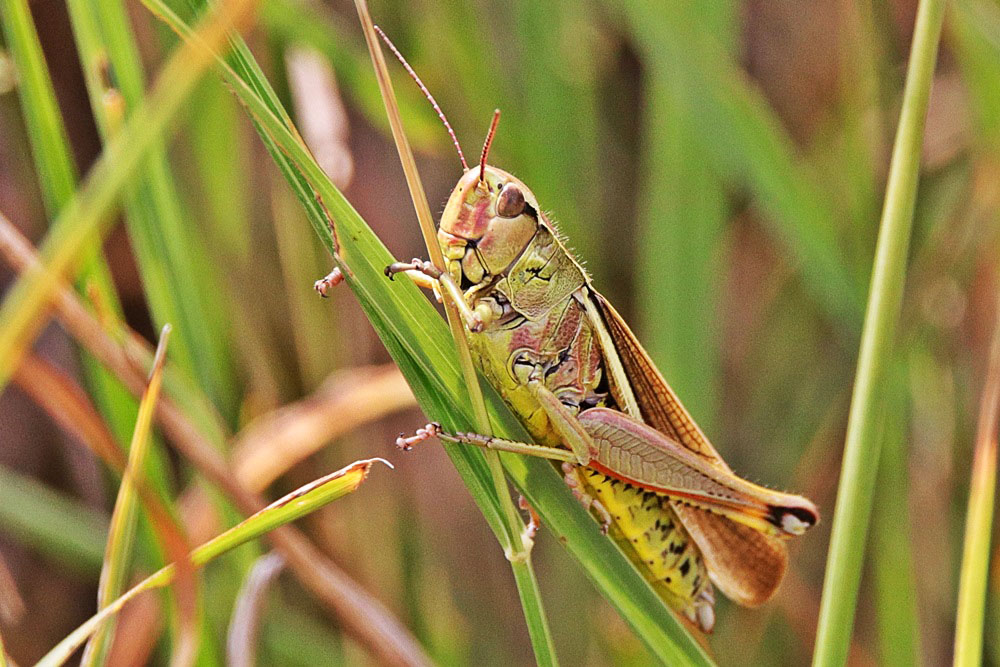 The marsh grasshopper (Stetophyma grossum) is one of the species that are endangered due to the decline in near-natural wetlands and therefore benefits from the (re-) watering of the adjacent wet meadows.
The marsh grasshopper (Stetophyma grossum) is one of the species that are endangered due to the decline in near-natural wetlands and therefore benefits from the (re-) watering of the adjacent wet meadows.
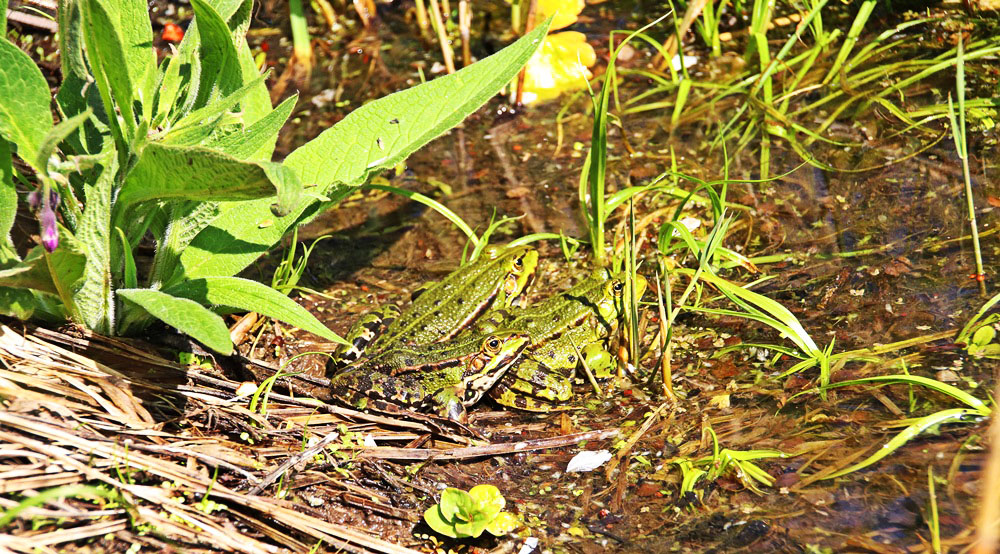 Green frogs (Pelophylax spec.) are among the few amphibians that live in water all year round and feed on small creatures here. In the sun-drenched shallow water zones, the animals can be observed in large numbers while sunbathing. If there is danger, they jump into the protective water and bury themselves in the mud.
Green frogs (Pelophylax spec.) are among the few amphibians that live in water all year round and feed on small creatures here. In the sun-drenched shallow water zones, the animals can be observed in large numbers while sunbathing. If there is danger, they jump into the protective water and bury themselves in the mud.
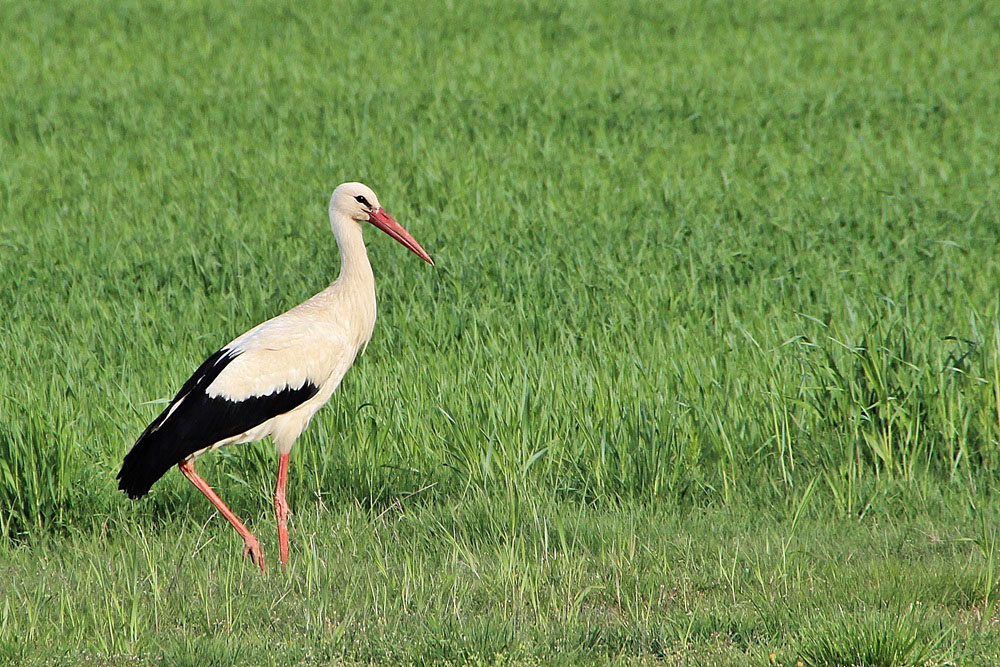 White Storks (Ciconia ciconia) use the wide range of food on the wet meadows for rearing their young birds. In addition to frogs and mice, the prey spectrum also includes grass snakes, lizards and grasshoppers.
White Storks (Ciconia ciconia) use the wide range of food on the wet meadows for rearing their young birds. In addition to frogs and mice, the prey spectrum also includes grass snakes, lizards and grasshoppers.
Text and photos:
